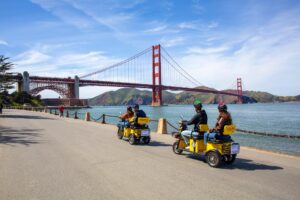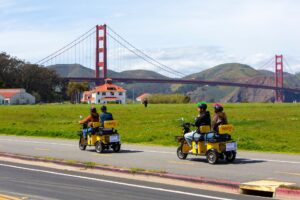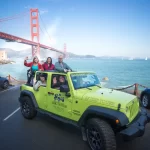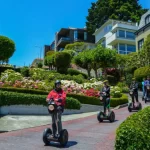San Francisco’s Chinatown: A Thriving Community Amidst Adversity
San Francisco’s Chinatown is not just a neighborhood; it’s a living testament to the resilience and vibrant culture of the Chinese-American community. In this article, we’ll delve into the detailed history, fascinating facts, and must-visit locations that make Chinatown an integral part of San Francisco’s identity.
History of Chinatown: A Timeline of Triumph Over Adversity
1848: The Gold Rush Wave
- The first wave of Chinese immigrants arrives during the California Gold Rush.
- Young men seeking economic opportunities are drawn to the bustling port of San Francisco.
1850s: Discrimination and Challenges
- Discrimination and racism against Chinese immigrants intensify.
- Chinese laborers face violence, job denials, and housing discrimination.
1870s: Chinese Exclusion Act
- The Chinese Exclusion Act is passed, effectively banning Chinese immigration for over six decades.
- Chinatown becomes more self-sufficient, with its businesses, schools, and institutions.
20th Century: Resilience and Growth
- Despite adversity, the Chinese-American community thrives.
- Chinatown becomes the largest Chinese community on the West Coast.
16 Fascinating Facts About Chinatown
- Dragon’s Gate: The iconic entrance to Chinatown is the Dragon’s Gate at Grant Avenue and Bush Street, adorned with jade-colored roofs and dragon sculptures.
- Unique Shopping: Explore novelty shops offering everything from Buddha figurines to Chinese medicine balls and even chirping crickets.
- Chinese New Year Festival: The world-famous Chinese New Year Festival and Parade celebrates the Lunar New Year with a dazzling parade, featuring the impressive Golden Dragon.
- Farmer’s Market: Visit the bustling Farmer’s Market on Stockton Street for a true taste of daily life.
- Chinese-Inspired Architecture: Discover buildings like the Bank of China, Sing Chong Building, and Sing Fat Building, showcasing Chinese architectural influence.
- Portsmouth Square: Known as the “Heart of Chinatown,” this plaza offers historical markers, statues, and playgrounds.
- The Wok Shop: Find authentic woks, cleavers, and Chinese cooking utensils at this hidden gem on Ross Alley.
- Chinese Historical Society of America Museum: Explore the history and culture of Chinese immigrants in America on Clay Street.
- Chinese Culture Center: Located on Kearny Street, it offers cultural classes, including language, dance, and calligraphy.
- Chinese Music Institute: Learn traditional Chinese music instruments like erhu, guzheng, and dizi on Jackson Street.
- Golden Gate Fortune Cookie Factory: Witness handmade fortune cookies being made at Ross Alley.
- Chinese Consolidated Benevolent Association: Discover this historical landmark on Stockton Street, showcasing Chinese-American culture.
- Dragons Gate: A traditional stone archway welcoming visitors to Chinatown since 1970.
- Unique Geography: Chinatown covers 24 square blocks and overlaps five postal ZIP codes.
- Stockton Street: Experience an authentic Chinese atmosphere with produce and fish markets, stores, and restaurants.
- Tin How Temple: The oldest Chinese temple in the United States, dedicated to the goddess Tin How, stands on Waverly Place.
10 Must-Visit Locations in Chinatown
- Dragon’s Gate: Start your journey through Chinatown at this iconic entrance.
- Portsmouth Square: Explore the historical heart of Chinatown.
- The Wok Shop: Discover authentic cooking utensils at this hidden store.
- Chinese Historical Society of America Museum: Dive into the history of Chinese immigrants in America.
- Chinese Culture Center: Immerse yourself in cultural classes and activities.
- Chinese Music Institute: Learn traditional music on unique Chinese instruments.
- Golden Gate Fortune Cookie Factory: Witness the art of making fortune cookies by hand.
- Chinese Consolidated Benevolent Association: Understand the cultural and historical significance of this landmark.
- Tin How Temple: Visit the oldest Chinese temple in the U.S. on Waverly Place.
- Stockton Street: Explore the bustling markets, stores, and restaurants for an authentic experience.
San Francisco’s Chinatown is not just a tourist attraction; it’s a living, breathing community with a rich history and a promising future. Whether you’re fascinated by history, and culture, or simply love exploring vibrant neighborhoods, a visit to Chinatown is a must on your San Francisco itinerary.
Your Ultimate Guide to Exploring San Francisco’s Chinatown
San Francisco’s Chinatown is a vibrant and culturally rich neighborhood that offers a fascinating blend of history, cuisine, and traditions. With its pagoda-style architecture, ornate lamp posts, exotic menus, and other distinctive elements, a visit here can feel more like a trip abroad than a neighborhood stroll. In this guide, we’ll show you how to make the most of your visit to Chinatown, from iconic landmarks to hidden gems and delicious dining spots.
Getting to Chinatown
Chinatown is conveniently located and accessible by various modes of transportation:
- On Foot: If you’re in neighborhoods like North Beach, Nob Hill, Union Square, or the Financial District, walking is the best way to reach Chinatown.
- Cable Car: You can add a touch of nostalgia by taking the Powell-Hyde or Powell-Mason cable car lines from Fisherman’s Wharf or Union Square. Get off between Jackson and Bush Streets for easy access to Chinatown.
- Bus: The 30-Stockton bus route runs right through the center of Chinatown. Any stops between Broadway and Bush Streets will get you to the neighborhood quickly.
- BART: If you prefer public transit, the Chinatown Rose-Pak Station on the Central Subway line provides easy access to Chinatown.
- Taxi or Ride-Sharing: Taxis and ride-sharing services like Lyft and Uber are readily available and convenient for reaching Chinatown.
The Dragon Gate
Location: Grant Avenue & Bush Street
Your Chinatown adventure begins at the iconic Dragon Gate. This stunning portal, gifted by Taiwan, welcomes both cars and pedestrians into the heart of Chinatown. Take a moment to admire the lion and lioness statues guarding the archway, symbolizing prosperity, and the intricate dragon designs signifying fertility and power at the gate’s top.
Waverly Place
Location: Between Washington and Sacramento Streets
Waverly Place, just a block west of Grant Avenue, is the soul of Chinatown. It’s a street filled with painted balconies adorned with lanterns, temples, and family-run businesses. Notably, you’ll find the Michelin-starred Mister Jiu’s restaurant here. Amy Tan fans might recognize it as the setting for “The Joy Luck Club,” and movie buffs may have seen it in “The Pursuit of Happyness.”
Tin How Temple
Location: 125 Waverly Place, San Francisco, CA 94108
The oldest surviving Taoist temple in San Francisco, Tin How Temple is nestled into busy Waverly Place. Climbing three flights of stairs, you’ll be greeted by calming incense as you pay your respects to the Chinese sea goddess Mazu. The temple, rebuilt after the 1906 earthquake, remains a testament to resilience.
Grant Avenue
Start at: Grant Avenue & Bush Street
Grant Avenue, formerly Dupont Street, is San Francisco’s first street and boasts iconic architecture and an abundance of neon signs. Here, you’ll find Chinese lanterns, souvenirs, jade, antiques, and some well-loved bars like Buddha Lounge, LiPo Cocktail Lounge, and Bow Bow Cocktails. It’s the main tourist artery of Chinatown and a great place to start your exploration.
Stockton Street Markets
For a taste of Chinatown as the locals know it, head to Stockton Street. Here, residents sell everything from ducks hanging in windows to fresh Chinese produce and traditional herbs from crowded storefronts that often spill onto the sidewalks. To experience the liveliest markets, visit on a Saturday when the neighborhood does most of its shopping.
Location: Stockton Street, between Sacramento & Broadway
Golden Gate Fortune Cookie Factory
Location: 56 Ross Alley, San Francisco, CA 94133; Phone: 415-781-3956
No visit to Chinatown is complete without a stop at the Golden Gate Fortune Cookie Factory, the last remaining fortune cookie factory in San Francisco. Watch as cookies are assembled by hand with the help of a conveyor belt. You’ll even receive a free sample of the most delectable warm fortune cookie. Don’t miss unique flavors like chocolate and green tea, or the option to get a pack of 50 fortune cookies with custom messages inside.
Chinese Historical Society of America Museum
Location: 965 Clay St., San Francisco, CA 94108; Phone: 415-391-1188 x109
To delve into the history and experiences of Chinese immigrants in America, visit the Chinese Historical Society of America Museum. Housed in a historic Chinatown YWCA building designed by renowned architect Julia Morgan, the museum offers fascinating galleries, tours, events, and interactive learning opportunities. Explore exhibits on Bruce Lee and miniature models of iconic Chinatown scenes.
Great Star Theater
Location: 636 Jackson St., San Francisco, CA 94133; Phone: 415-735-4159
Step into the past at the Great Star Theater, the last remaining venue from Chinatown’s golden era of Chinese opera. This 500-seat theater, built in 1925, has undergone revitalization efforts and now hosts a variety of performances, movie screenings, and cultural events. It’s a testament to preserving local theater, cabaret, variety shows, and Chinese opera in San Francisco.
Portsmouth Square
Bounded by Washington and Clay Streets from north to south and Kearny Street and Walter U. Lum Place from east to west, Portsmouth Square is a historic public space with a rich history. It’s where the American flag was first raised in 1846 and where the discovery of gold was announced two years later. Today, you’ll find residents playing cards, practicing Tai Chi, and children enjoying the “Tot Lot.” Don’t miss the picturesque footbridge leading to the Chinese Cultural Center.
Dr. Sun Yat-Sen Statue
Location: Saint Mary’s Square, 651 California St., San Francisco, CA 94108
In Saint Mary’s Square, you’ll find a 14-foot statue of Dr. Sun Yat-Sen, China’s first provisional president. The statue honors his efforts to raise funds for the political revolution while in San Francisco, where he often addressed the local community. Dr. Sun Yat-Sen’s legacy is an integral part of the neighborhood’s history.
Exploring Chinatown
The best way to immerse yourself in Chinatown is on foot. Consider taking walking tours that capture the neighborhood’s history, flavors, and personality. The Bruce Lee Walking Tour showcases 10 destinations and three murals for Bruce Lee enthusiasts. For design enthusiasts, the Chinatown Neon tour showcases the city’s rare neon signs, many of which are found in Chinatown’s best bars.
How to Get to Chinatown
- Cable Car: Take the Powell-Mason or Powell-Hyde lines from Union Square, Fisherman’s Wharf, or Ghirardelli Square.
- Public Transportation: Use the Chinatown Rose-Pak Station at Washington and Stockton streets, served by the Central Subway line.
- Parking: Street parking can be challenging, but some metered spots are available, and Sundays are free. Parking garages like SFMTA Sutter Stockton Garage and Portsmouth Square Garage are convenient options with day rates ranging from $30 to $40.
Exploring San Francisco’s Chinatown is an unforgettable journey filled with rich culture, delicious food, and a deep sense of history.







